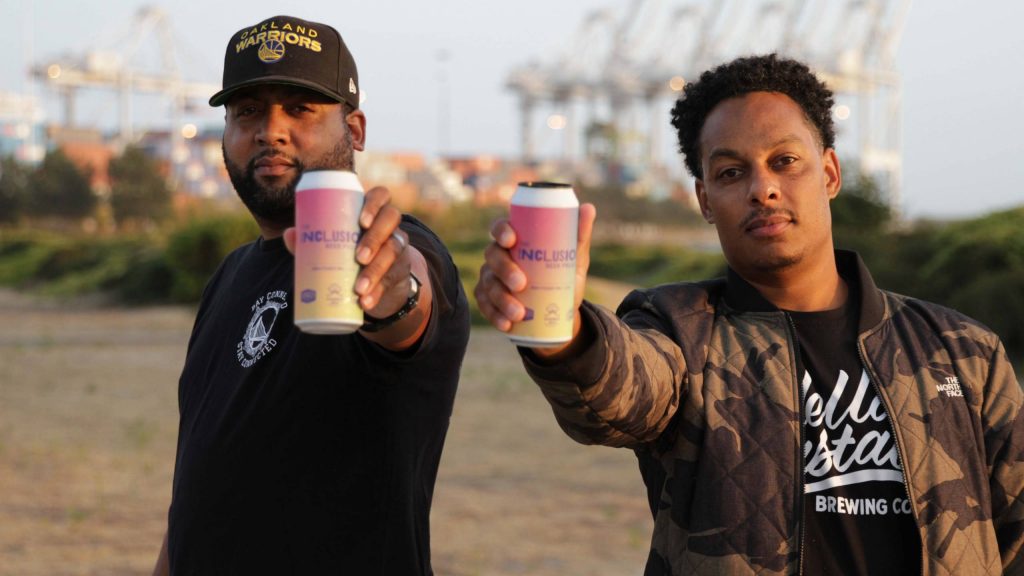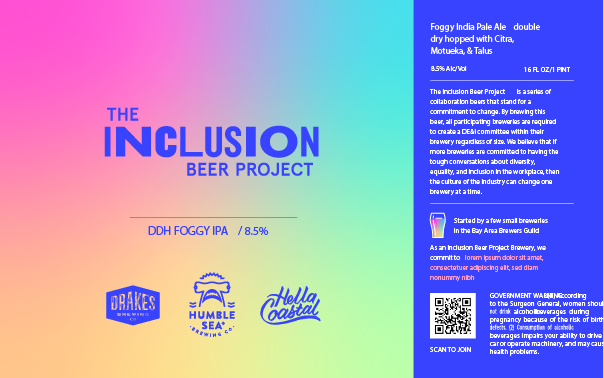The Inclusion Beer Project
A Collaboration for Diversity, Equity, and Inclusion
by Tom Lyon
In the craft beer community today, there are a number of efforts to improve diversity, equity, and inclusion, or DEI for short. One of these movements, the Inclusion Beer Project (IBP), is gathering momentum in the East Bay Area, and is being spearheaded by the Bay Area Brewer’s Guild along with several Guild members. As the IBP launched during the pandemic, the original idea of hosting in-person events was scrapped in favor of an ongoing collaborative movement, including beer releases from participating breweries.
Recently, the Guild did a benchmark survey in order to get an idea of how representative (or not) the Bay Area beer scene was for historically marginalized communities. DeVonne Buckingham, brewmaster at Drake’s Brewing in San Leandro, as well as Chair of the Bay Area Brewer’s Guild DEI Committee, says the results of the survey were a bit disappointing. Being in the diverse Bay Area, Buckingham said they were expecting to see significantly more representation across Black, Hispanic, LGBTQ+, and Asian demographics than the results of the survey indicated.
The benchmark survey done by the Bay Area Brewer’s Guild also revealed that in particular, management and ownership positions were severely underrepresented outside of straight white males, although this falls in line with the national statistics for craft beer.
Read the benchmark survey results here.
Just another beer collaboration project?
The IBP has some similarities to other collaborative beer-related efforts of late, but it differs on a key point as well. Like some other group movements, the ultimate goal is to increase the diversity of people throughout the craft beer space, from taproom consumer all the way up to brewery management and ownership. One important avenue to effecting this positive change is by enabling and leading conversations around the issues present in craft beer; in this particular case, a lack of diverse representation in craft beer (besides straight white males).
By signing up for the IBP, participants agree to form a DEI committee within their organization. This committee is a great forum for hosting conversations around inclusivity and what can be done to further the cause, and then actually implementing those changes. These conversations, which can guide us through uncomfortable (yet often necessary) changes, are ultimately how we grow and become better humans, businesses, and brands.
Significantly, one way in which the IBP differs from many other social movements is that there is no specific monetary component to participation. Whereas other collaborations, whether local, national, or global, have been tied to financial donations to various non-profits or social advocacy groups, the IBP doesn’t require or ask for a buy-in or donation in order to participate. What is an absolutely critical component to participation in the IBP is the formation of a DEI committee. The importance of this is underscored by the fact that the IBP offers resources to help breweries and businesses begin engaging in those difficult conversations around inclusion in its many forms as it relates to society, beer, and beyond.
Rather than setting a fundraising goal or donation requirement, Buckingham says that the project has no set end date or specific financial incentive. As listed on the IBP’s website, the whole purpose behind the project is to spark conversation in order to help people begin to take positive action, which will ultimately manifest in creating the positive change needed in the industry. Without that critical first step of engaging in conversation, it’s difficult to imagine real, lasting change coming to fruition.

Why does it matter?
So why is this initiative important? Why does it matter to have these kinds of conversations? Well, in case you happen to live under a very large rock, the craft beer space is incredibly disproportionately made up of straight white males (beard optional). Suffice to say, the craft beer industry has a long way to go to achieve equal representation.
Putting in the work to build diversity and representation in the craft beer industry matters because when we get to see, hear, and taste more diverse perspectives, we all win.
To that end, the Bay Area Brewer’s Guild is in the process of organizing an endowment that will help underrepresented groups access high quality brewing education through the University of California, Davis. While still working through the paperwork process, the endowment is nearing launch and will certainly make an immediate impact.
A caution against hiring for posterity
Chaz Hubbard, co-founder of Hella Coastal Brewing and a core contributor to the IBP, says that breweries (and businesses in general) should be careful not to hire diverse people solely for filling out the “diversity checkbox”.
“Hire people for their qualifications, not just for their skin color,” says Hubbard. One way to proactively do this is to seek out qualified candidates that may not be currently employed in the craft beer field. Some skills are related enough to translate between similar fields, such as certain barista skills working for bartenders and brewers.
As an example, there are many skills in beer, such as some cellar work and packaging (among other important brewery jobs), that can be taught to inexperienced new hires who fit the mold of a good human being that you want working for you. Just because somebody is new to the industry doesn’t mean they should be relegated to busser or food runner, especially if they have the desire to learn.
Think outside the straight white box
Thinking outside the box when it comes to hiring is a great way to help increase diversity in the brewing industry. Participating in job fairs or hitting up the local community college job board can yield a much more diverse field of applicants than hiring somebody who already works in craft beer.
Another thing Hubbard warns against is hiring people to fill a job simply because they have the right connections. His personal experiences trying to get into the craft beer industry over a decade ago have informed this thought, when he had a tough time finding the right fit after discovering a passion for homebrewing, but not knowing the “right” people to get in the door.
Hubbard also says that the way job postings are worded can unintentionally filter out diverse applicants. If a job listing says that applicants must have brewery experience, when in reality they just need some service industry experience and the desire to learn, it can set up roadblocks to quality employees who haven’t worked at a brewery, but want to.
Where do we go from here?
As the IBP is a relatively new initiative, Buckingham says they are still searching for the proper balance between bringing awareness to the project, and holding participating breweries accountable to the tenets they agree to.
“What kind of measurables do we use?” and “What actually drives change?” are questions she says the Guild are still grappling with. Hubbard echoed the same sentiment, and said that IBP participants should be ready to answer questions from their community as to how they are being proactive in diversity hiring and inclusionary efforts. Signing up to participate in the IBP is a great place to start, but it’s only the beginning. It truly is a commitment and an ongoing effort to be inclusive.
The Inclusion Beer Project is, by definition, meant to bring underrepresented folks into the fold of craft beer. Craft beer is far from the only industry that can benefit from increased diversity. There is no perfect solution to this problem, but perhaps the most important thing we can do is start having these conversations. After all, the IBP is defined as an open-ended project that serves as a great conversation starter, opening the door to a more inclusive community, industry, and world.
There are a range of quotes surrounding the idea of having a seat at the table, or conversely building an entirely new table. While the quotes all differ, they tend to offer up the same idea: whether the table be expanded, restructured, or destroyed and rebuilt, it’s long past time for the table to look like a proper representation of our society.

You can learn more about the Inclusion Beer Project, or sign up to participate, at their website: https://inclusionbeerproject.com/





